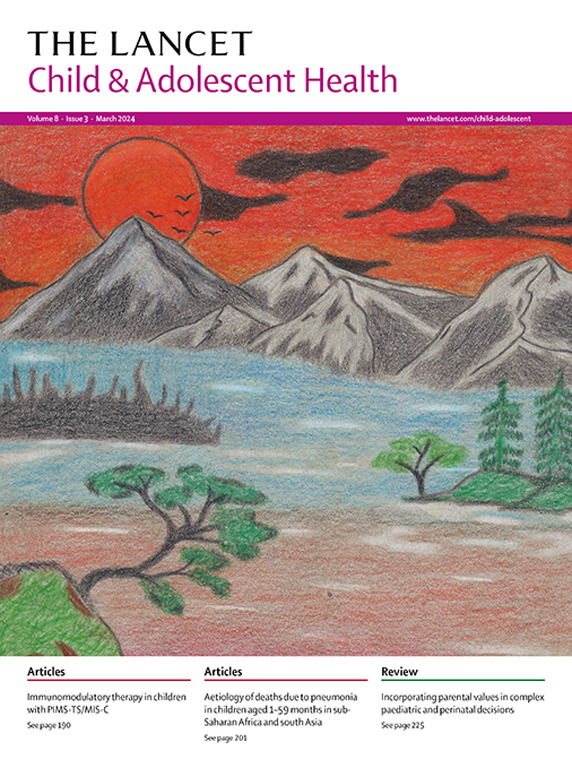南非与虐待和忽视儿童有关的谋杀案:2009 年和 2017 年两次全国性调查的比较。
摘要
背景:只有在拥有可靠的全国谋杀儿童统计数据的国家,才能定期获得基于人口的虐待和忽视儿童死亡统计数据。对于低收入和中等收入国家而言,人们对儿童谋杀案的流行趋势知之甚少。南非是一个例外,该国对 2009 年和 2017 年的儿童谋杀案进行了专门的国家研究,提供了儿童谋杀案的总体数据以及与虐待和忽视儿童相关的谋杀案数据。我们旨在比较南非两次调查中与虐待和忽视儿童相关的谋杀案,以确定 2009 年至 2017 年间的任何变化:我们从南非的医学法律实验室中按比例随机抽样,对 2009 年和 2017 年基于停尸房的 0-17 岁儿童谋杀案进行了两次回顾性全国调查。我们为每个研究年份准备了一个医学法律实验室抽样框架,并根据医学法律实验室的规模进行了分层。在收集数据之前,至少允许在犯罪发生后两年内进行调查,以便使调查过程取得进展。与虐待和忽视儿童相关的谋杀案是通过法医实验室尸检报告和警方数据确定的。为了确定与虐待和忽视儿童相关的谋杀案,我们主要使用了在照顾责任安排背景下发生的虐待框架,但将其扩大到包括从数据中确定的所有犯罪者和虐待行为。我们将年龄分为 0-4、5-9、10-14 和 15-17 岁,并将 5 岁以下的儿童进一步分为早期新生儿(出生后 6 天内死亡的新生儿)、7 天至 11 个月的儿童和 1-4 岁的儿童。我们计算了发病率比(IRR)及 95% CI,以比较 2009 年至 2017 年的发病率:据估计,2009 年有 458 名(95% CI 为 377-539 名)儿童在虐待和忽视儿童的情况下被谋杀,2017 年有 213 名(179-247 名)儿童在虐待和忽视儿童的情况下被谋杀。从2009年到2017年,与虐待和忽视儿童有关的谋杀案占所有儿童谋杀案的比例有所下降(2009年为458起[45-0%],占1018起;2017年为213起[25-0%],占851起),总体年龄标准化比率从每10万名0-17岁儿童中2-6起降至1-1起(IRR为0-43[95% CI为0-35-0-54])。在 2009 年的 458 起谋杀案中,女孩占 276 起(60-3%),而在 2017 年的 213 起谋杀案中,女孩占 96 起(45-1%);在 2009 年的 458 起谋杀案中,男孩占 178 起(38-9%),而在 2017 年的 213 起谋杀案中,男孩占 109 起(51-4%)。0-4岁(IRR为0-33[0-22-0-49])和5-9岁(0-33[0-15-0-73])年龄组的女童和0-4岁年龄组的男童(0-49[0-33-0-71])的死亡率下降具有统计学意义。在早期新生儿(出生后 6 天内)中,与虐待和忽视儿童相关的谋杀案的减少在女孩中比在男孩中更为明显(IRR 0-33 [95% CI 0-19-0-56] vs 0-46 [0-28-0-77]):在南非,与虐待和忽视儿童有关的谋杀案很常见,但我们的研究表明,这些谋杀案是可以减少的。这些谋杀案的高发率表明,有必要继续开展研究和监测,以便为有针对性的优先干预措施提供信息,并更好地了解儿童抚养政策的影响:福特基金会和南非医学研究委员会。Background
Population-based statistics on deaths from child abuse and neglect are only routinely available in countries that have reliable national statistics on child murder. For low-income and middle-income countries, relatively little is known about prevalence trends of child murder. South Africa is an exception, having conducted dedicated national studies on child murders for 2009 and 2017 to provide data on child murders overall and on child abuse and neglect-related murders. We aimed to compare child abuse and neglect-related murders in South Africa across two surveys to determine any change between 2009 and 2017.
Methods
We conducted two retrospective national mortuary-based surveys on murder of children aged 0–17 years for 2009 and 2017 from a proportionate random sample of medico-legal laboratories in South Africa. A sampling frame of medico-legal laboratories for each study year was prepared with stratification by medico-legal laboratory size. A minimum of 2 years after the crime was allowed before data collection to enable progression of the investigation process. Child abuse and neglect-related murders were identified using both medico-legal laboratory post-mortem autopsy reports and police data. To identify a child abuse and neglect-related murder, we primarily used the framework of abuse happening within the context of responsibility of care arrangements but broadened this to include all perpetrators and abuse identified from the data. We stratified age into 0–4, 5–9, 10–14, and 15–17 years and further stratified children younger than 5 years into early neonates (newborns killed within 6 days of birth), 7 days to 11 months, and 1–4 years. We calculated incidence rate ratios (IRR) with 95% CIs to compare rates between 2009 and 2017.
Findings
An estimated 458 (95% CI 377–539) children in 2009 and 213 (179–247) children in 2017 were murdered in circumstances of child abuse and neglect. The percentage of all child murders that were child abuse and neglect-related declined from 2009 to 2017 (458 [45·0%] of 1018 in 2009 vs 213 [25·0%] of 851 in 2017), with the overall age-standardised rate decreasing from 2·6 to 1·1 per 100 000 children aged 0–17 years (IRR 0·43 [95% CI 0·35–0·54]). Girls represented 276 (60·3%) of 458 murders in 2009, which declined to 96 (45·1%) of 213 murders in 2017, and boys represented 178 (38·9%) of 458 murders in 2009 and 109 (51·4%) of 213 murders in 2017. The decrease was statistically significant for girls in the 0–4 year (IRR 0·33 [0·22–0·49]) and 5–9 year (0·33 [0·15–0·73]) age groups and for boys in the 0–4 year age group (0·49 [0·33–0·71]). Among early neonates (within 6 days of birth), the decrease in child abuse and neglect-related murders was more pronounced among girls than among boys (IRR 0·33 [95% CI 0·19–0·56] vs 0·46 [0·28–0·77]).
Interpretation
Child abuse and neglect-related murders are common in South Africa but our study shows that they can be reduced. The high rate of these murders points to the need to continue research and monitoring to inform priority targeted interventions and to better understand the impact of child support policies.
Funding
Ford Foundation and South African Medical Research Council.

 求助内容:
求助内容: 应助结果提醒方式:
应助结果提醒方式:


